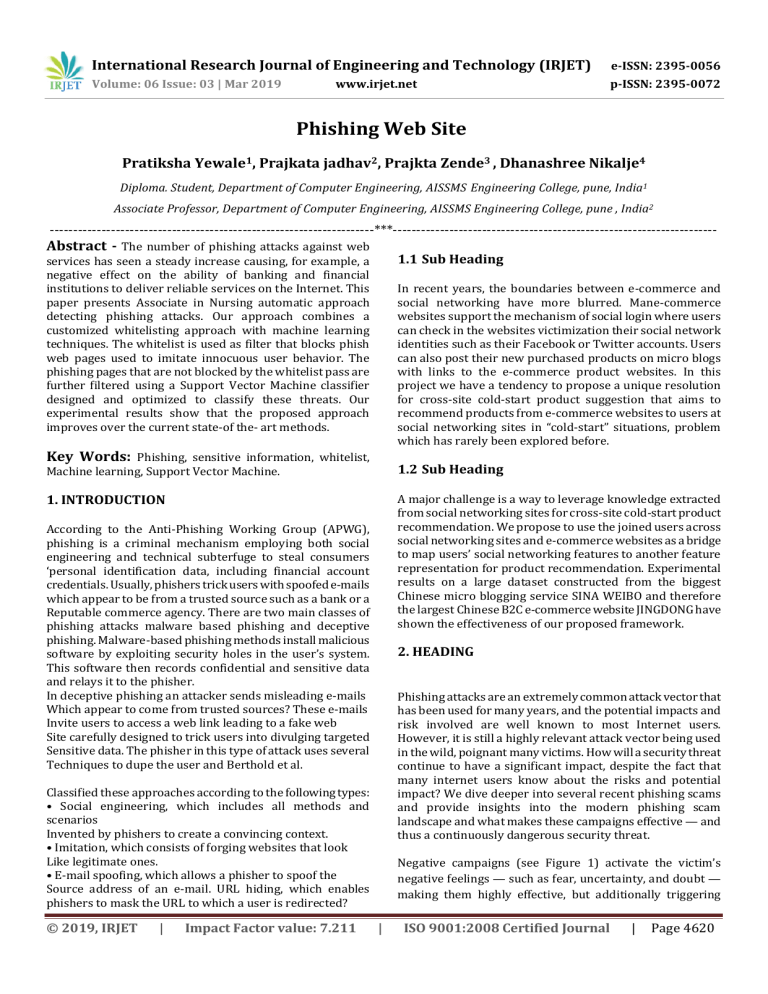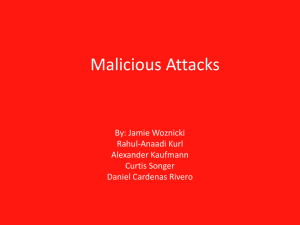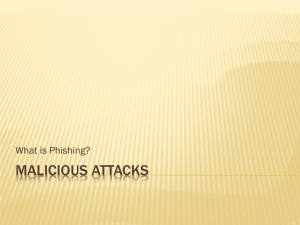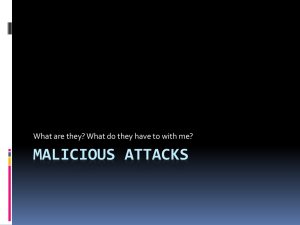
International Research Journal of Engineering and Technology (IRJET)
e-ISSN: 2395-0056
Volume: 06 Issue: 03 | Mar 2019
p-ISSN: 2395-0072
www.irjet.net
Phishing Web Site
Pratiksha Yewale1, Prajkata jadhav2, Prajkta Zende3 , Dhanashree Nikalje4
Diploma. Student, Department of Computer Engineering, AISSMS Engineering College, pune, India1
Associate Professor, Department of Computer Engineering, AISSMS Engineering College, pune , India2
---------------------------------------------------------------------***---------------------------------------------------------------------
Abstract - The number of phishing attacks against web
1.1 Sub Heading
services has seen a steady increase causing, for example, a
negative effect on the ability of banking and financial
institutions to deliver reliable services on the Internet. This
paper presents Associate in Nursing automatic approach
detecting phishing attacks. Our approach combines a
customized whitelisting approach with machine learning
techniques. The whitelist is used as filter that blocks phish
web pages used to imitate innocuous user behavior. The
phishing pages that are not blocked by the whitelist pass are
further filtered using a Support Vector Machine classifier
designed and optimized to classify these threats. Our
experimental results show that the proposed approach
improves over the current state-of the- art methods.
In recent years, the boundaries between e-commerce and
social networking have more blurred. Mane-commerce
websites support the mechanism of social login where users
can check in the websites victimization their social network
identities such as their Facebook or Twitter accounts. Users
can also post their new purchased products on micro blogs
with links to the e-commerce product websites. In this
project we have a tendency to propose a unique resolution
for cross-site cold-start product suggestion that aims to
recommend products from e-commerce websites to users at
social networking sites in “cold-start” situations, problem
which has rarely been explored before.
Key Words: Phishing, sensitive information, whitelist,
Machine learning, Support Vector Machine.
1.2 Sub Heading
1. INTRODUCTION
A major challenge is a way to leverage knowledge extracted
from social networking sites for cross-site cold-start product
recommendation. We propose to use the joined users across
social networking sites and e-commerce websites as a bridge
to map users’ social networking features to another feature
representation for product recommendation. Experimental
results on a large dataset constructed from the biggest
Chinese micro blogging service SINA WEIBO and therefore
the largest Chinese B2C e-commerce website JINGDONG have
shown the effectiveness of our proposed framework.
According to the Anti-Phishing Working Group (APWG),
phishing is a criminal mechanism employing both social
engineering and technical subterfuge to steal consumers
‘personal identification data, including financial account
credentials. Usually, phishers trick users with spoofed e-mails
which appear to be from a trusted source such as a bank or a
Reputable commerce agency. There are two main classes of
phishing attacks malware based phishing and deceptive
phishing. Malware-based phishing methods install malicious
software by exploiting security holes in the user’s system.
This software then records confidential and sensitive data
and relays it to the phisher.
In deceptive phishing an attacker sends misleading e-mails
Which appear to come from trusted sources? These e-mails
Invite users to access a web link leading to a fake web
Site carefully designed to trick users into divulging targeted
Sensitive data. The phisher in this type of attack uses several
Techniques to dupe the user and Berthold et al.
2. HEADING
Phishing attacks are an extremely common attack vector that
has been used for many years, and the potential impacts and
risk involved are well known to most Internet users.
However, it is still a highly relevant attack vector being used
in the wild, poignant many victims. How will a security threat
continue to have a significant impact, despite the fact that
many internet users know about the risks and potential
impact? We dive deeper into several recent phishing scams
and provide insights into the modern phishing scam
landscape and what makes these campaigns effective — and
thus a continuously dangerous security threat.
Classified these approaches according to the following types:
• Social engineering, which includes all methods and
scenarios
Invented by phishers to create a convincing context.
• Imitation, which consists of forging websites that look
Like legitimate ones.
• E-mail spoofing, which allows a phisher to spoof the
Source address of an e-mail. URL hiding, which enables
phishers to mask the URL to which a user is redirected?
© 2019, IRJET
|
Impact Factor value: 7.211
Negative campaigns (see Figure 1) activate the victim’s
negative feelings — such as fear, uncertainty, and doubt —
making them highly effective, but additionally triggering
|
ISO 9001:2008 Certified Journal
|
Page 4620
International Research Journal of Engineering and Technology (IRJET)
e-ISSN: 2395-0056
Volume: 06 Issue: 03 | Mar 2019
p-ISSN: 2395-0072
www.irjet.net
defensive impulses in some cases. In contrast, “positive”
campaigns highlight feelings of pleasure, hope, and gratitude,
and are gaining momentum. As “positive” campaigns interact
with victims’ positive feelings, they are frequently combined
with elements of social networks, making these campaigns
much more effective. We area unit seeing growing
momentum in the threat landscape of attacks that square
measure starting to include elements of diversion, social
networks, and prize winning. All of these elements serve the
threat actor’s main goal: to gain the user’s trust and lead
victims to divulge sensitive information. This trust is also
used to spread the phishing campaign, by group action steps
that require the target to share the content via the target’s
social network, thereby increasing the campaign’s impact and
distribution.
making them highly effective, but additionally triggering
defensive impulses in some cases. In contrast, “positive”
campaigns highlight feelings of pleasure, hope, and gratitude,
and are gaining momentum. As “positive” campaigns interact
with victims’ positive feelings, they are frequently combined
with elements of social networks, making these campaigns
much more effective. We area unit seeing growing
momentum in the threat landscape of attacks that square
measure starting to include elements of diversion, social
networks, and prize winning. All of these elements serve the
threat actor’s main goal: to gain the user’s trust and lead
victims to divulge sensitive information. This trust is also
used to spread the phishing campaign, by group action steps
that require the target to share the content via the target’s
social network, thereby increasing the campaign’s impact and
distribution.
On broader perspective phishing attacks can be classified into
two categories: social engineering or deceptive phishing and
malware-based phishing attacks. Social engineering phishing
attacks generally engage psychological exploitation of users
or tricking company employees into handing over their
private data. [14–16] These attacks occurs through fake
emails, which seems legitimate otherwise or some other
social platforms that appeals to certain emotions in the
victim, where victim ends up in click a malicious link, or
releasing sensitive information, The users with less technical
expertise fell easily for social engineering attacks, so
endeavors must put efforts to educate employees against
these attacks, in order to stay two steps ahead of hackers and
prevent these attacks from succeeding Similarly, malwarebased phishing engages running malicious software or
unnecessary programs on the user’s machine
On broader perspective phishing attacks can be classified into
two categories: social engineering or deceptive phishing and
malware-based phishing attacks. Social engineering phishing
attacks generally engage psychological exploitation of users
or tricking company employees into handing over their
private data. [14–16] These attacks occurs through fake
emails, which seems legitimate otherwise or some other
social platforms that appeals to certain emotions in the
victim, where victim ends up in click a malicious link, or
releasing sensitive information, The users with less technical
expertise fell easily for social engineering attacks, so
endeavors must put efforts to educate employees against
these attacks, in order to stay two steps ahead of hackers and
prevent these attacks from succeeding Similarly, malwarebased phishing engages running malicious software or
unnecessary programs on the user’s machine.
Conclusion
It has been approximately 20 years since the phishing
problem was acknowledged. But, still it is used to steal
personal
Himani Thakur et al, International Journal of Advanced
Research in Computer Science, 7 (4) July-August 2016,64-68
© 2015-19, IJARCS All Rights Reserved 67
information, online documentations and credit card details.
There are diverse solutions offered, but whenever a result is
proposed to overcome these attacks, phishers come up with
the vulnerabilities of that solution to maintain with such an
attack. Phishing attacks can be classified generally into two
categories: Social engineering, which refers to obtaining
user’s testimonial using emails or fake websites, and
malware attacks, which use malicious code or software to
obtain the data required. There are several approaches to
shield the user from email and website phishing and were
examined in this document.The appraisal helps new
researchers to identify with the history, current inclinations
of attacks and failure of various accessible solutions. Defense
Fig -1: Sample Image
Negative campaigns (see Figure 1) activate the victim’s
negative feelings — such as fear, uncertainty, and doubt —
© 2019, IRJET
|
Impact Factor value: 7.211
|
ISO 9001:2008 Certified Journal
|
Page 4621
International Research Journal of Engineering and Technology (IRJET)
e-ISSN: 2395-0056
Volume: 06 Issue: 03 | Mar 2019
p-ISSN: 2395-0072
www.irjet.net
against phishing attacks is one of the hardest confronts faced
by the network security these days.
REFERENCES
[1] The Phishing Guide Understanding & Preventing
Phishing Attacks By: Gunter Ollmann, Director of Security
Strategy, IBM Internet Security Systems, 2007
[2] Phishing: Cutting the Identity Theft Line Published by
Wiley Publishing, Inc. 10475 Crosspoint Boulevard
Indianapolis, IN 46256 www.wiley.com, 2005, Rachael
Lininger and Russell Dean Vines
[3] Anti-Phishing Working Group (APWG), ‘‘Phishing
activity
trends
report—first
quarter
2013.dsreportq12013.pd f, accessed September 2014
[4] Aloul F (2010) The need for effective information
security awareness. Int J Intell Comput Res 1(3):176–183 [5]
James L (2005)
[5] Phishing exposed. Syngress Publishing, Burlington 6.
Anti-Phishing Working Group (APWG) (2015) Phishing
activity trends report- fourth quarter 2015 .
[6] Anti-Phishing Working Group (APWG) (2014) Phishing
activity trends report—first quarter 2014. Accessed Sept
2014
[7] Anti-Phishing Working Group (APWG) (2014) Phishing
activity trends report—fourth quarter 2013. Accessed Sept
2014
[8] Anti-Phishing Working Group (APWG) (2014) Phishing
activity trends report—second quarter 2013.
[9] Anti-Phishing Working Group (APWG) (2014) Global
Phishing Survey—second half 2013.
[10] IT Business Edge (2014) Spear phishing, targeted
attacks and data breach trends.
[11] Pierluigi Paganini (2014) Phishing: a very dangerous
cyber threat
[12] Krebs B (2014) HBGary federal hacked by anonymous.
[13] eCrime Trends Report: Fourth Quarter (2013)
http://Internetidentity.com/resource-tags/quarterlyecrimereports/. Accessed Sept 2014
[14] Jakobsson M, Myers S (2007) Phishing &
countermeasures:understanding the increasing problem of
electronic identity theft. Wiley, New York
[15] Sheng S, Magnien B, Kumaraguru P, Acquisti A, Cranor
LF, Hong J, Nunge E (2007) Anti-phishing phil: the design
and evaluation of a game that teaches people not to fall for
phish. In: Proceedings of the SOUPS, Pittsburg, pp 88–99
© 2019, IRJET
|
Impact Factor value: 7.211
|
ISO 9001:2008 Certified Journal
|
Page 4622



